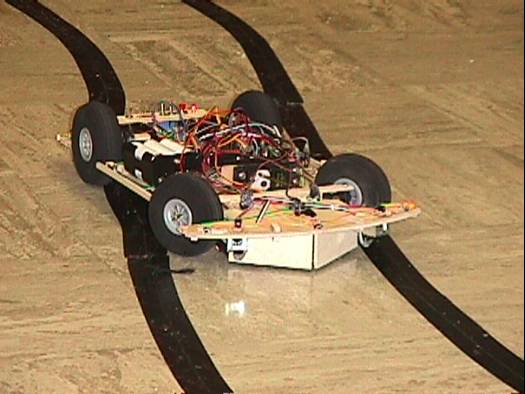| Robot | Creator | Description | Final Paper |
Sailbot
|
Michael Barfield | No description yet |
sailbot.pdf |
One-eye

|
Robert Cavin | Gyro-scopic robot. | gyrobot.pdf |
Stilt Walker

|
Dan Crews | No description yet | stilt.pdf |
Scavbots

|
David Gridlinger | No description yet |
scavbots.pdf C Source code |
TransAm2

|
Jason W. Grzywna | Trans Am was designed to model an autonomous vehicle. By performing actions representative of an actual passenger vehicle it could simulate driving. It performs driving by following dark lines representing lanes. It first starts off of the lines, aquires the outer most line (they are concentric odd shaped circles), and proceeds to change to another inner line to avoid obstacles. It has the ability to keep changing lanes (both in and out) to avoid obstacles within its path. |
Final Report AutoCAD files Logic Flow Project Files (ZIP) Other Stuff |
Range Rover

|
Andrew Janecek | Range Rover is an autonomous robot that is designed to clean a designated area of golf balls. The designated area is marked by an electronic fence, which is just a commercially available pet fence. Range Rover is not designed to cover a typical driving range since the area is too large, but rather an area about the size of a household lawn. The platform consists of an electric RC car which pulls a trailer behind it. This trailer is used to collect balls into a basket while counting how many balls have been collected. Collision avoidance is provided by a front bumper. |
rangerover.pdf C source code AutoCAD files |
ASCA

|
Steve Lewis | ASCA explores the intricacy of designing and building an autonomous agent that climb stairs. The agent is intended to be small in size and be an economical solution. ASCA was implemented with a single pltform that uses two posts (one front and one rear). These post are able to raise and lower the body. ASCA is primarily a mechanical oriented poject, utilitizing only two types of sensors: IR and bump switches. ASCA was unable to perform autonomously due to technical hardware problems with interference from the motors. |
asca.pdf C source code AutoCAD files |
Kisa

|
Cynthia Manya | Kisa is an entertaining cat-like robot that has four legs and uses heat, force, light, and proximity sensors to realize its behaviors. It can also generate cat sounds. | kisa.pdf |
A-Train

|
Nathan Nipper | A-TRAIN is an autonomous robot train that follows train tracks in the form of a dark line. A-TRAIN resembles an actual train with a locomotive, cargo car, and caboose. The robot uses micro-switches, photocells, infrared detectors and a ptentiometer to provide the processor with information about the environment in order to properly execute behaviors. The potentiometers allow the train to back up like a trailer. The photocells provide the ability to see the train tracks. If no tracks are visible, A-TRAIN will navigate around trying to find a track to follow. The micro-switches and infrared detectors allow for obstacle and collision avoidance. | a-train.pdf |
High Five

|
Jack Peach | No description yet | hi5.pdf |
Short Fuse

|
Greg Porter | No description yet | shortfuse.pdf |
Squirtle

|
Chris Seiffert | No description yet | squirtle.pdf |
Nav-bot

|
Chris Thomas | The Nav-bot is an autonomous robot that uses a compass to perform navigation. The compass headings are used to compare the current course to the desired course and then the robot makes adjustments accordingly. | navbot.pdf |
Skippy the Firefighting Robot

|
Warren Thornton, Jr. | No description yet | skippy.pdf |
Smurf

|
Boris Yaw | Smurf is an autonomous small object manipulating robot. It was designed to fit into a cylinder 7 inches in diameter and 4 inches tall with a retractable arm that extends about three inches outside of this cylinder. Smurf is designed to pick up an object, and carry this object in its gripper to another location. Ideal objects would fit in a 2 inch cube and weigh less than 8 ounces. Smurf uses 5 servos(1 sub micro servo for the grippers and four standard servos, two for propulsion and two for arm motion) Smurf is controlled using a 6811 microcontroller and uses bump switches, IR, CDS cells and a microphone to preform either random searches w/object avoidance, or line following in order to locate small objects and move them. | smurf.pdf |